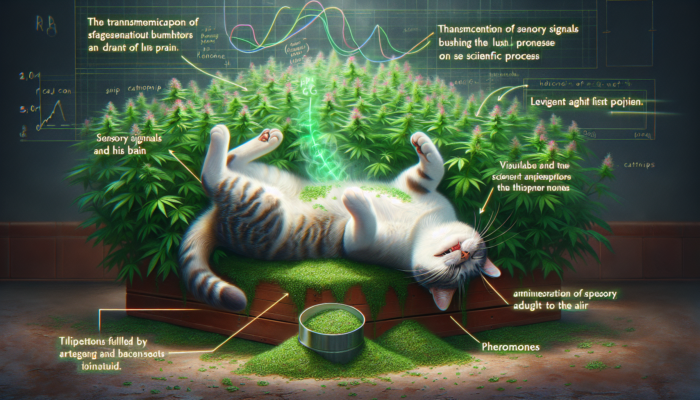Unlock the Secrets of Catnip: Understanding Feline Reactions and Behavior Patterns
Diving into the catnip reactions in cats offers a wealth of fascinating insights into the intriguing behaviors displayed by our beloved feline friends. The herb known as catnip, scientifically referred to as Nepeta cataria, has the remarkable ability to elicit euphoric responses in many cats, turning their playful natures into exhilarating displays bursting with energy and enthusiasm. It’s crucial to note that not every cat will react; understanding the science behind these varied responses can illuminate why some cats revel in this herb while others show little interest. By comprehending these reactions, cat owners can greatly improve their relationships with their furry companions and enhance their overall well-being.
Understanding the Biological Mechanisms Behind Catnip’s Effects on Cats

At the heart of the catnip reaction in cats is a unique compound known as nepetalactone, found in the leaves and stems of the catnip plant. When cats engage with catnip—through sniffing, licking, or chewing—it activates sensory receptors within their nasal tissues. This interaction triggers a cascade of sensory signals that travel to the brain, particularly stimulating areas associated with emotions. As a result, cats frequently enter a euphoric state characterized by behaviors such as rolling, rubbing against objects, and vocal expressions of joy.
This reaction mirrors pheromonal responses similar to how cats respond to specific scents or interactions with other felines. Typically, the euphoric effects of catnip last for about 10 to 15 minutes; afterward, cats often appear indifferent, necessitating a break before they can respond again. This cyclical behavior can recur several times throughout the day, reinforcing catnip’s unique role as a stimulant for our cherished companions. By understanding these responses, cat owners can create enriching experiences that resonate with their pets’ natural instincts, fostering healthy play and deeper engagement.
Examining How Age and Genetics Influence Cats’ Responses to Catnip
The variations in how cats respond to catnip can largely be attributed to both age and genetic factors. Research indicates that sensitivity to catnip is hereditary, with estimates suggesting that between 50% to 75% of cats exhibit a positive reaction. Kittens, especially those under six months of age, typically do not respond to catnip because they lack the necessary receptors for nepetalactone.
As cats mature, their reactions may evolve. Many older cats show a diminished response to catnip, potentially due to changes in sensory perception or health issues associated with aging. Certain breeds, such as Siamese and Abyssinian, are known to exhibit heightened sensitivity to catnip when compared to other breeds.
This genetic dimension adds complexity to the understanding of the catnip reaction in cats, making it an intriguing subject for cat owners eager to learn more about their pets. Acknowledging these individual differences allows owners to customize their enrichment and play strategies, ensuring they interact with their cats in ways that resonate with their unique personalities and instincts.
Evaluating the Duration and Intensity of Catnip Reactions Across Different Cats
The duration and intensity of the catnip reaction can greatly differ from one cat to another. After initial exposure, the effects of catnip typically peak within a few minutes. While some cats may spring into action, darting around the room, others might respond more subtly, displaying calm behaviors such as purring or gently rubbing against the catnip source. This variability is influenced by numerous factors, including the cat’s personality, environmental context, and their previous experiences with catnip.
The intensity of the reaction also reveals considerable diversity. Some cats may exhibit exuberant behavior, while others might prefer a more relaxed state. Following the initial high, cats usually enter a refractory phase that can last anywhere from 30 minutes to several hours, during which their interest in catnip diminishes. Observing this cycle can be especially captivating, reflecting not only the immediate effects of the herb but also the individual personality traits of each cat.
Understanding the intricacies of reaction duration and intensity can aid cat owners in crafting more engaging environments. For instance, strategically introducing catnip toys at various intervals can sustain a cat’s interest and encourage play without overwhelming them. Recognizing when a cat is most responsive to catnip can also deepen the bond between owner and pet, contributing to a more enriching playtime experience.
Delving into the Cultural and Historical Importance of Catnip in Feline Lives

Catnip carries a rich historical narrative that parallels our growing understanding of feline behavior. Initially regarded as a humble garden herb, its significance has evolved over centuries, reflecting the profound bond between humans and their feline companions.
Tracing the Ancient Uses and Discovery of Catnip Throughout History
The historical applications of catnip date back to ancient civilizations. In ancient Egypt, the herb was valued not only for its effects on cats but also for its medicinal properties. It was employed to treat various ailments, showcasing an early recognition of the herb’s benefits. Ancient texts suggest that catnip was integrated into rituals and used to attract cats, which were revered as sacred beings.
As trade routes expanded, catnip found its way into European gardens, cultivated for both feline enjoyment and human medicinal use. It often served as a herbal remedy for digestive issues and anxiety, highlighting its versatility. This combination of practical applications and cultural significance underscores catnip’s longstanding role in human history.
Today, the historical uses of catnip continue to inform modern practices, encouraging cat owners to explore the numerous benefits of this herb for their pets. This rich history adds context to the catnip reaction in cats, reminding us of the ancient connection shared between felines and this extraordinary plant.
The Evolution of Catnip Cultivation and Its Market Availability
With the increasing popularity of catnip, its cultivation has seen significant advancements. Once simply a wild herb, catnip is now commercially grown to meet the rising demand from cat owners. The growth of the pet industry has led to a boom in catnip-related products, ranging from toys to sprays, all designed to engage our feline companions in stimulating ways.
Modern cultivation practices now prioritize quality and sustainability. Many growers are adopting organic farming methods, reflecting a heightened awareness of environmental issues among consumers. Today, catnip is often cultivated without harmful pesticides, ensuring it remains safe for both cats and the planet.
This evolution in cultivation not only benefits cat owners but also underscores the importance of responsible sourcing. As the demand for catnip continues to rise, being informed about its production can enhance the overall experience for both cats and their human companions, ensuring that the catnip reaction in cats remains a safe and joyful aspect of their lives.
Latest Scientific Research and Findings on Feline Catnip Reactions

Recent scientific studies have shed light on the mechanisms that govern the catnip reaction in cats. Researchers are delving into the neurochemical processes involved, investigating how nepetalactone influences the feline brain. This research clarifies why some cats respond enthusiastically to catnip, while others show little to no interest.
Moreover, ongoing studies into the genetic basis of catnip sensitivity are providing intriguing insights. By analyzing the DNA of various breeds, scientists are uncovering heritable traits linked to the catnip reaction. This knowledge could expand our understanding of feline behavior and enhance our interactions with our pets.
As we continue to deepen our knowledge of the biology and chemistry of catnip, we can also explore its potential therapeutic benefits. Some studies suggest that catnip may have calming effects, offering relief to stressed or anxious cats. This emerging field of research holds promise for enhancing our comprehension of cats and their relationships with this captivating herb.
Enhancing the Cat Experience: Leveraging the Catnip Reaction for Owners
Grasping the catnip reaction in cats opens a myriad of opportunities for cat owners. By harnessing the effects of catnip, we can enrich our cats’ lives, promote healthy behaviors, and strengthen our bond with them.
Using Catnip to Encourage Play and Physical Activity in Cats
One of the most effective applications of catnip is its ability to inspire play and exercise in our feline friends. Cats are instinctual hunters, and incorporating catnip-infused toys into their play can unleash their natural playful instincts. The alluring scent of catnip encourages cats to engage in high-energy play, providing both physical and mental stimulation.
Interactive toys filled with catnip can transform a dull afternoon into a thrilling playtime. When cats chase, pounce, and bat at these toys, they expend excess energy, minimizing the risk of obesity and related health issues. Integrating catnip into playtime can turn ordinary moments into exhilarating adventures that keep our pets active and engaged.
Additionally, the benefits of active play extend beyond physical health. Engaging in play with catnip toys can strengthen the bond between cats and their owners, fostering a sense of companionship. By understanding how to leverage the catnip reaction in cats, owners can create an enriching environment that nurtures their furry friends’ inherent instincts, promoting a happier and healthier life.
Employing Catnip as a Tool for Positive Behavioral Reinforcement
Catnip can also serve as an effective training tool for modifying unwanted behaviors in cats. For example, if a cat is scratching furniture, strategically introducing catnip can redirect their focus to an appropriate scratching post. Sprinkling catnip in designated areas encourages cats to engage with those items, reinforcing positive behavior.
In addition to redirecting scratching behaviors, catnip can help alleviate anxiety-related issues. When introducing a new environment or altering a cat’s routine, incorporating catnip can provide a soothing effect. The calming properties of catnip can ease transitions, making it a valuable tool for owners dealing with behavioral challenges in their pets.
Using catnip as a training aid requires careful consideration; it’s crucial to avoid overuse or reliance. Instead, catnip should complement other training methods, encouraging a holistic approach to behavior modification. By integrating the catnip reaction in cats into training strategies, owners can cultivate a more harmonious living environment for their furry companions.
Utilizing Catnip to Reduce Stress and Anxiety in Cats
The calming effects of catnip are well-documented, making it a valuable resource for alleviating stress and anxiety in cats. Many felines experience stress due to environmental changes, loud noises, or the arrival of new family members. In these instances, introducing catnip can help create a soothing atmosphere that encourages relaxation.
Research indicates that the effects of catnip may mimic pheromonal responses, fostering a sense of security and comfort. This is especially beneficial during stressful situations like veterinary visits or transitioning to a new home. By providing a safe environment enriched with catnip, owners can facilitate their cats’ navigation through anxiety-inducing scenarios more smoothly.
Furthermore, regular exposure to catnip can promote a more relaxed demeanor in cats, positively impacting their overall well-being. Striking a balance between play and relaxation is vital for a cat’s mental health. By recognizing the calming effects of catnip, owners can create a nurturing environment that caters to their cats’ emotional needs, establishing it as a crucial component of feline care.
Health and Safety Considerations for Catnip Usage with Cats
While the catnip reaction in cats is generally safe and enjoyable for most felines, it’s essential for owners to consider health and safety factors when introducing this herb into their pets’ lives.
Recognizing Potential Risks and Side Effects Linked to Catnip Use
Although catnip is typically safe for cats, there are potential risks and side effects that owners should be mindful of. Some cats may experience mild gastrointestinal distress if they consume excessive amounts of catnip, resulting in symptoms like vomiting or diarrhea, though such occurrences are uncommon.
Additionally, a small percentage of cats might display heightened excitement or aggression when exposed to catnip, leading to unwanted behaviors. It is imperative for cat owners to carefully monitor their pets during and after catnip exposure, especially during the initial introduction.
Being aware of these potential risks empowers owners to make informed choices regarding catnip usage. By gradually introducing catnip and observing their cat’s reactions, owners can minimize the likelihood of negative effects, ensuring a positive experience for their cherished pets.
Establishing Guidelines for the Responsible Use of Catnip
To ensure the safe application of catnip, owners should follow several guidelines. First and foremost, moderation is essential. Offering catnip in small amounts allows cats to enjoy its effects without becoming overwhelmed. It is advisable to limit exposure to a few times per week, facilitating the natural cycle of interest and indifference.
When introducing catnip, selecting high-quality, organic products is crucial. This ensures that the catnip is free from harmful chemicals or pesticides. Providing fresh catnip or premium dried leaves can significantly enhance the overall experience for cats, leading to a more potent and enjoyable reaction.
Furthermore, designating a specific area for catnip play can help contain any mess while ensuring a safe environment for cats to enjoy the herb. By adhering to these guidelines, owners can safely incorporate the catnip reaction in cats into their pets’ lives, enhancing their well-being and enjoyment.
Exploring Alternative Options for Cats That Don’t React to Catnip
Not every cat will respond to catnip, prompting owners to seek alternative methods to engage their feline friends. Fortunately, several substitutes can offer similar effects for those cats who do not react to catnip.
One popular alternative is silver vine (Actinidia polygama), a plant that often elicits a strong response in cats that do not react to catnip. Silvervine contains two compounds—actinidine and actinidine glycoside—that can induce a euphoric reaction, making it an excellent substitute for enhancing a cat’s playtime.
Another option is valerian root, which is renowned for its calming effects in humans and stimulating responses in cats. Offering valerian-infused toys or dried valerian can promote both play and relaxation for cats that do not respond to catnip.
By exploring these alternatives, owners can ensure that every cat has opportunities for enjoyment and stimulation, regardless of their reaction to traditional catnip. Understanding the variety of available options enriches the overall experience of feline companionship and emphasizes the importance of tailoring care to each cat’s unique needs.
Building a Stronger Connection Between Cats and Owners Through Catnip Reactions
The catnip reaction in cats offers more than just entertaining moments; it creates invaluable opportunities to reinforce the bond between cats and their owners. By engaging thoughtfully with catnip, we can cultivate shared experiences that enhance our relationships with our furry companions.
Encouraging Interactive Play Through Catnip-Infused Toys
Catnip toys serve as excellent tools for interactive play, allowing owners to engage with their cats in dynamic and stimulating ways. Whether utilizing a simple catnip-stuffed mouse or a complex interactive puzzle toy, these products facilitate bonding through shared playtime.
When cats interact with catnip toys, they exhibit their natural hunting behaviors, such as pouncing and swatting at their “prey.” This not only satisfies their instinctual drives but also fosters interactions with their owners. Participating in these play sessions cultivates a sense of companionship, as both cat and owner share in the excitement and joy of play.
Moreover, engaging in interactive play promotes physical health, helping to keep cats active and agile. Regular play sessions using catnip toys can develop into cherished routines, reinforcing the emotional connection between cats and their owners. By understanding the nuances of the catnip reaction in cats, owners can create enjoyable experiences that fortify their bond with their feline friends.
Creating a Catnip Garden for Enrichment and Enjoyment at Home
For those eager to elevate their catnip experience, cultivating a catnip garden at home provides both enjoyment and enrichment. Growing catnip not only offers fresh leaves for cats to indulge in but also serves as a delightful gardening project for owners.
Catnip is relatively easy to cultivate in various environments, requiring minimal maintenance. By planting catnip in pots or directly in the garden, owners can create a sustainable source of this herb for their furry companions. The experience of nurturing plants can be rewarding, and the resulting fresh catnip can significantly enhance play sessions, creating a sensory wonderland for cats.
Additionally, a catnip garden can beautify any home, creating a space where cats can explore and enjoy. This connection to nature benefits the cats and promotes mindfulness and well-being for their owners. By embracing the concept of a catnip garden, both cats and humans can indulge in life’s simple pleasures.
Sharing Personal Stories and Experiences Related to Catnip Reactions
The communal aspect of pet ownership is powerful, and sharing stories about the catnip reaction in cats can help build connections among cat owners. Online forums, social media platforms, and local pet events serve as venues for individuals to exchange experiences, tips, and insights regarding catnip and its effects on their cats.
Sharing personal anecdotes can provide valuable learning opportunities for others. Many owners possess unique insights into their cats’ responses to catnip, from amusing antics to unexpected behaviors. These narratives not only entertain but also educate, helping to demystify the complexities of feline behavior.
Moreover, community engagement can foster a sense of belonging among cat owners. By participating in discussions and sharing experiences, individuals can connect with like-minded people who share their passion for their feline companions. This sense of community enhances the overall experience of pet ownership, reminding us that we are not alone in our journey with our cherished cats.
Current Trends and Innovations in the Catnip Industry: What to Anticipate
As the catnip market continues to grow, so do the trends and innovations surrounding this beloved herb. Staying informed about the latest developments can help cat owners make the best choices for their pets.
Discovering Innovative Catnip Products and Formulations
The catnip industry has witnessed a surge of innovative products designed to enhance the catnip reaction in cats. From catnip-infused bubbles to interactive toys that dispense catnip, the variety of offerings continues to expand. These new products aim to engage cats in exciting ways, promoting play and exploration.
Innovative formulations, such as catnip sprays and concentrated oils, have also emerged in the market. These products enable owners to easily apply catnip to various surfaces or toys, simplifying the process of refreshing their cat’s interest. Such innovations cater to the needs of cats while providing convenience for busy owners seeking to enhance enrichment in their pets’ lives.
The ongoing evolution of catnip products highlights a growing awareness of feline well-being and the essential role that play has in a cat’s life. By staying updated on new developments, owners can ensure they provide the best experiences for their beloved companions.
Organic and Sustainable Catnip Options for Eco-Conscious Consumers
With the rise of environmentally conscious consumerism, organic and sustainable catnip options are increasingly in demand. Many cat owners are now more mindful of the products they choose, opting for catnip cultivated without harmful chemicals or pesticides.
Organic catnip not only benefits cats but also supports sustainable farming practices. By selecting organic products, owners contribute to a healthier planet while ensuring their pets enjoy the purest form of catnip. Numerous brands are emphasizing their commitment to eco-friendly practices, simplifying the decision-making process for consumers.
This trend toward sustainability aligns with the growing awareness of the impact of individual consumption on the environment. By prioritizing organic and sustainable catnip, owners can enhance their cats’ experiences while positively impacting the world around them.
The Future of Catnip Research and Development: Looking Ahead
As research into the catnip reaction in cats progresses, the potential for future discoveries is immense. Scientists are examining various aspects of catnip, from its chemical composition to its broader impacts on feline behavior. This ongoing research promises to deepen our understanding of how catnip interacts with the feline brain and influences behavior.
Future studies may also investigate the therapeutic potential of catnip, exploring its calming effects and possible applications in managing stress for cats. With the increasing interest in holistic pet care, the prospects for catnip research are promising.
By keeping abreast of advancements in catnip research, owners can stay informed about best practices for their cats. As our understanding of catnip evolves, so too will our ability to enhance the lives of our feline companions.
Dispelling Common Myths and Misunderstandings About Catnip Reactions
As with many aspects of pet care, misconceptions about catnip are widespread. Addressing these myths empowers owners to navigate the complexities of the catnip reaction in cats with clarity and confidence.
Debunking the Myth That All Cats Love Catnip
One of the most prevalent myths surrounding catnip is the belief that all cats adore it. In reality, sensitivity to catnip is hereditary, with estimates suggesting that roughly 50% to 75% of cats exhibit a positive response. Kittens typically do not react until they reach maturity, which can lead to misunderstandings regarding the herb’s appeal.
Understanding this variability is vital for cat owners. Just because a cat does not respond to catnip does not mean it lacks enjoyment or stimulation. Recognizing that not every cat shares the same preferences allows owners to seek alternative enrichment options, ensuring that every cat can flourish, regardless of their reaction to catnip.
Clarifying the Differences Between Catnip and Cat Grass
Another common misconception involves the confusion between catnip and cat grass. While both are enjoyed by many felines, they serve distinct purposes and produce different effects. Catnip, a member of the mint family, induces euphoric reactions, while cat grass—often made up of wheat, oat, or barley—provides dietary fiber and aids digestion.
Understanding these distinctions enables owners to make informed decisions about what to offer their cats. By incorporating both catnip and cat grass into a cat’s diet, owners can provide a comprehensive approach to enrichment and health.
The Truth About Catnip Addiction in Cats: Important Insights
Concerns about catnip addiction are common, leading many owners to question whether their cats can develop a dependence on this herb. The good news is that cats do not become addicted to catnip; their reactions are temporary, and sensitivity can fluctuate based on exposure.
While cats may display energetic behavior when exposed to catnip, it is essential to manage their intake responsibly. Allowing breaks between exposures ensures that the effects remain enjoyable and helps prevent overstimulation. By understanding the nature of the catnip reaction in cats, owners can guarantee their cats have positive experiences without the risk of dependency.
Engaging with the Cat Community: Sharing Insights on Catnip Reactions
Connecting with the broader cat community can enrich the experience of understanding and enjoying the catnip reaction in cats. By engaging with fellow cat enthusiasts, owners can exchange insights, stories, and tips that enhance their journey with their feline friends.
Joining Online Communities and Social Media Groups Focused on Catnip
Online forums and social media groups provide excellent platforms for cat owners to discuss their experiences with catnip. These virtual communities offer opportunities for individuals to share stories about their cats’ reactions, seek guidance, and learn from one another.
Participation in these groups fosters a sense of belonging, as owners connect with others who share their passion for cats. By exchanging tips on catnip products, play strategies, and health considerations, members can deepen their understanding of feline behavior and care.
Moreover, these platforms can serve as spaces for advocacy, promoting responsible pet ownership and educating others about the benefits and risks associated with catnip. Engaging with the cat community in this manner elevates the experience of pet ownership, providing valuable connections and insights.
Participating in Catnip-Themed Events and Competitions
Unique events and competitions celebrating the catnip reaction in cats are gaining traction. From cat shows to themed playdates, these gatherings present opportunities for socialization and enjoyment. Participating in catnip-focused events allows owners to witness firsthand how different cats respond to catnip in a vibrant, communal atmosphere.
These events can also serve as platforms for education, where experts share insights about feline behavior, health, and enrichment strategies. Engaging in these experiences allows cat owners to cultivate a deeper appreciation for the nuances of catnip and its effects on their pets.
Moreover, such events promote community spirit, uniting cat lovers from diverse backgrounds. The camaraderie that develops through shared experiences further enhances the joy of pet ownership.
Collaborating with Veterinarians and Pet Experts to Expand Understanding
Collaborating with veterinarians and pet experts can significantly enrich our understanding of the catnip reaction in cats. Professionals in the field can provide invaluable insights regarding health and safety considerations surrounding catnip use, guiding owners in making informed choices.
Regular consultations with veterinarians can assist owners in addressing concerns related to catnip, ensuring they remain informed about the latest research and best practices. Additionally, many veterinary clinics offer educational workshops or resources that delve into the science behind catnip and its effects on behavior.
By engaging with experts, owners can cultivate a more profound understanding of their cats’ needs, ultimately strengthening the bond between humans and felines. This collaboration fosters a holistic approach to pet care, ensuring that every cat receives the love and attention they deserve.
Exploring Cultural Perspectives on Catnip: A Global View
The catnip reaction in cats transcends geographical boundaries, influencing cultures and traditions around the world. Exploring these cultural perspectives enriches our understanding of catnip and its significance in the lives of both cats and their owners.
The Role of Catnip in Various Cultures and Traditions
Catnip has been embraced by numerous cultures throughout history. In many societies, it is celebrated for its effects on cats and is often utilized in rituals or offered to feline deities. In ancient Egypt, for example, cats were revered as sacred beings, and catnip was used to attract and honor them.
In other cultures, catnip has found a place in traditional medicine, highlighting its versatility beyond just feline enjoyment. Its calming properties have been acknowledged in herbal remedies, showcasing the herb’s wide-ranging benefits.
Understanding these cultural perspectives enables modern cat owners to appreciate the historical significance of catnip. By acknowledging its roots, we can celebrate the bond between humans and cats, enriching our experiences with this remarkable herb.
Artistic Representations of Cats and Catnip in Culture
The influence of the catnip reaction in cats extends into the realm of art and popular culture. Artists have long been captivated by the whimsical behaviors of cats influenced by catnip, depicting these scenes in various forms of creative expression.
From paintings to sculptures, artistic interpretations celebrate the unique relationship between cats and catnip. These works not only entertain but also capture the essence of feline playfulness, connecting viewers to the joy and wonder of cat ownership.
Furthermore, popular culture has embraced catnip, often portraying it in humorous or endearing contexts. This representation in media showcases the universal appeal of cats and their quirky behaviors, fostering a sense of camaraderie among cat lovers.
By exploring artistic interpretations of the catnip reaction in cats, owners gain insights into the broader cultural significance of their pets’ experiences. This appreciation for the arts can deepen the bond between cats and their owners, creating shared moments of joy and inspiration.
Catnip in Literature and Folklore: A Historical Perspective
Throughout history, catnip has made its mark in literature and folklore. Stories featuring cats often incorporate catnip as a symbol of playfulness and mischief, reflecting the herb’s enchanting effects on felines.
Folklore from diverse cultures has woven catnip into narratives that celebrate the bond between humans and animals. These tales frequently highlight the whimsical nature of cats, portraying them as mischievous yet lovable companions.
By delving into literature and folklore, modern cat owners can appreciate the rich tapestry of stories surrounding catnip and its impact on feline behavior. These narratives not only entertain but also serve as a reminder of the enduring connection between humans and their furry friends.
Frequently Asked Questions on Catnip Reactions in Cats
What is catnip, and what effects does it have on cats?
Catnip is a herb containing nepetalactone, which elicits euphoric reactions in many cats, resulting in behaviors such as rolling, rubbing, and playful antics.
Why do some cats not respond to catnip?
Sensitivity to catnip is hereditary, meaning not all cats possess the genetic predisposition to react. Approximately 50% to 75% of cats display a reaction.
How can I safely introduce catnip to my feline friend?
Introduce catnip gradually, starting with small amounts. Observe your cat’s reactions and limit exposure to a few times per week to prevent overstimulation.
Are there any risks associated with using catnip?
While generally safe, overconsumption of catnip may lead to mild gastrointestinal upset. Some cats might also display overexcitement or aggression.
What alternatives can I provide for cats that do not respond to catnip?
Alternatives like silver vine and valerian root can elicit similar stimulating effects for cats that do not react to catnip.
How long does the catnip reaction typically last?
The effects of catnip usually last around 10 to 15 minutes, after which cats may require a break before responding again.
Can catnip be used to alleviate stress in cats?
Yes, catnip can possess calming effects, making it useful for reducing anxiety and stress in cats, particularly during transitions or stressful situations.
Is it possible for cats to become addicted to catnip?
Cats do not become addicted to catnip; their reactions are temporary, and sensitivity can fluctuate based on exposure.
How can I create a catnip garden in my home?
Plant catnip in pots or a garden bed, ensuring it receives adequate sunlight and water. Fresh catnip can enhance your cat’s play experience.
What are the latest trends in catnip products?
Innovations include catnip-infused bubbles, concentrated sprays, and organic options, catering to the growing demand for unique and sustainable catnip products.
Connect with us on Facebook!
The Article: Catnip Reaction: Unraveling the Feline Frenzy Appeared First On Unity Pets.
The Article Catnip Reaction: Exploring the Feline Frenzy Unleashed Was Found On https://limitsofstrategy.com

